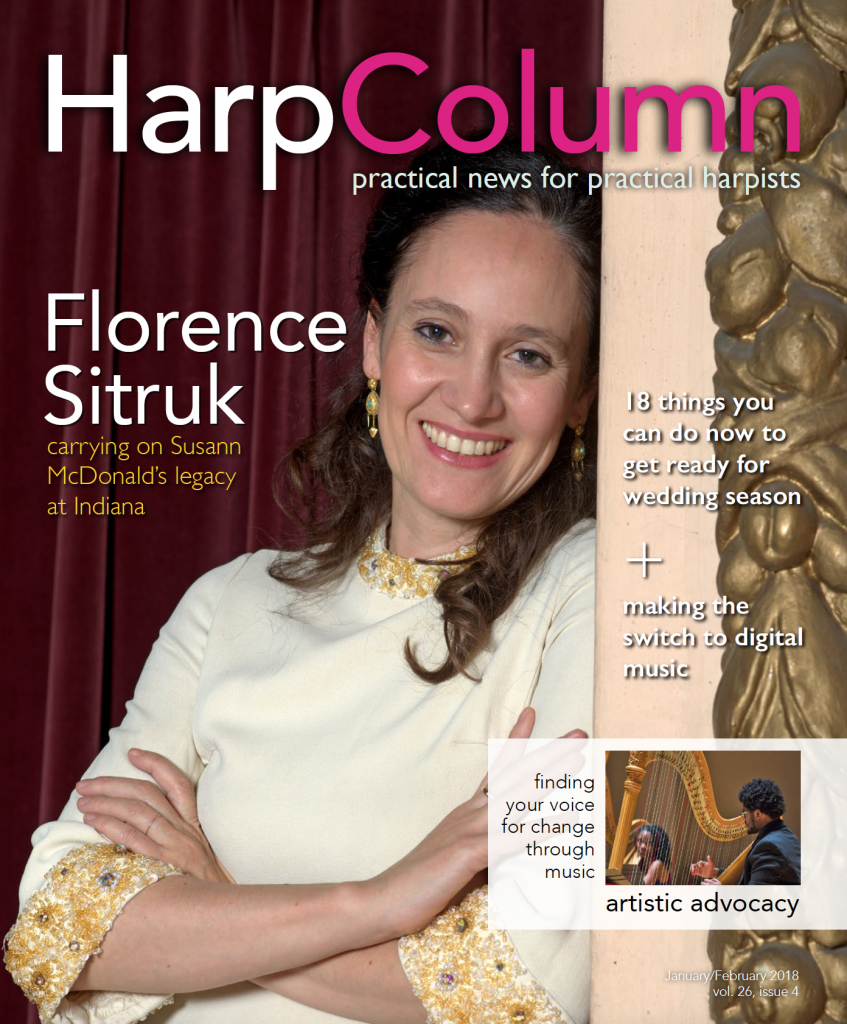I was playing a wedding gig at a venue in downtown Stillwater, Minn., that was new to me. Upon arrival I made a few unsuccessful passes along the main drag, hoping to secure one of those few coveted parking spots in the front of the building. No success. Stillwater isn’t one of those towns where you can ignore the parking rules, even for a few moments. As I crawled along at five miles per hour, trying to avoid cars and pedestrians, I decided to move on to plan B.
The back entrance of the venue was at the bottom of a very steep, dark, narrow alley, deep within a block of buildings. I parked at the top of the alley, hit my flashers, grabbed my chair and gig bag, and ventured down the slope into the building. Some lovely but very busy staff members directed me up the stairs to the main ballroom.
Returning to the car, I unloaded harp and cart and inched my way to the bottom of the steep hill, where I observed several details that had escaped me on the first trip.
I stood there balancing my concert grand pedal harp on its cart while the complication stared back at me, illuminated only by a single light bulb: an industrial weight, non-handicapped accessible door with an elevated threshold.
Every harp-schlepper can see the puzzle this presents. This particular back alley was unsurprisingly empty of the usual helpful passersby upon whom I invariably rely to hold doors for me. The sounds of downtown on a Saturday night wafted from beyond a wall of buildings, but not a soul was in sight.
The raised threshold forced me to pull rather than push my harp on its cart through the doorway. Desperate for ideas, I turned my back to the building and groped for the door handle. I could reach it; I could open the door. I backed two steps toward the building, holding the door open with one hand and pulling the harp with the other. I stopped. The door was too heavy; I couldn’t keep it open with my outstretched hand while leaning back far enough to hoist the cart over the threshold. I tried using my foot, and was able to hop back another half-foot or so, but not far enough to achieve the interior of the building.
“Wait!” I thought, “This is why I carry a doorstop in my purse!” I fished it out and looked at the bottom of the door frame. A 12-inch gap between the ground and the door meant a no-go on the doorstop idea.
I surveyed the deserted alley for a rock, a box, a dilapidated chair, anything. I considered seeking help inside the building. The busyness of the staff, the unprofessional move of commandeering a guest and dragging them from their celebration out to a dirty delivery entrance, the idea of leaving my harp unattended outside at night in an urban location, or worse yet, pulling the harp back up that hill, packing it in the car and then asking my helper to wait while I reversed the process—none of these options were appealing, and I was getting nervous about my timeline. I contemplated shoving the door open and dragging the harp backward as fast a possible, hopefully making it all the way through before the metal panel could smash closed on the front of my harp. I discarded the idea with a sick gulp and began foraging a bit further along the alley.
Finally, behind a nearby dumpster, I found a scrap of wood. After some experimentation I lodged the wood between door and frame, above the hinge. An imperfect solution, and probably not kind to the hardware, but with the offending portal propped three-quarters of the way open, I manhandled my instrument into the building and breathed a sigh of relief. Success. I carefully set the life-saving wood scrap in the corner for the return trip, and made a mental note to add a very large rock to the emergency gig kit I kept in my car.
Turning and looking to the doors at the end of the inside hallway, I thought, “I wonder how that freight elevator works?” •
—Stephanie Claussen
Stillwater, Minn.






